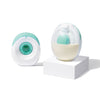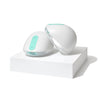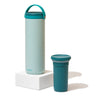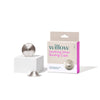If you have a newborn, you may feel like you’re feeding all the time. (That is, unless you're changing diapers or getting some shut eye while your baby sleeps.) But how do you know when your baby’s actually getting hungry again?
If you’re not sure when your little one is hungry, there are some common cues you can look for that mean “mom, it’s food time!” And the best part? Those first cues don’t include crying! Which means as you get better at recognizing these other cues (don’t worry, mama, you will), you’ll likely be able to avoid more of those ear-piercing crying sessions.
Ready to become fluent in baby hunger communication? Let’s dive into the different signs that your baby’s hungry, full, or just wants some comfort.
What do hunger cues look like?
There are many different ways your baby might try to communicate their hunger situation and believe it or not, most of them don’t include crying. In fact, crying tends to be babies’ last resort for trying to tell you their needs.
While every baby will communicate a little differently, most babies will have these tell tale signs that they’re feeling peckish. Catch the signs and bring on the boob (or bottle) quick enough, and you can avoid the hangry stage (we’ve all been there amiright?).
Signs your baby is hungry
Okay, let’s cut right to the important info here. In general, your baby will have three stages of hunger cues: the “I’m starting to feel peckish” stage, the “I’m SO hungry” stage, and the “I’M SO HUNGRY I’M SCREAMING” stage.
So what do those stages look like?
The early hunger cues include:
-
Opening and closing mouth
-
Waking up
-
Licking or smacking lips
-
Putting hands in mouth and sucking on anything and everything.
-
Clenching fists
At the middle or active stage, hunger cues may look like:
-
Becoming more alert and active
-
Rooting (moving head towards breast or from side to side with mouth open as though looking for the nipple)
-
Moving around, fidgeting and getting restless
-
Waving arms around or hitting you on the arm or chest
Ideally, you want to notice earlier hunger cues before you get to the late state, but you’ll probably see them at some point. They look like:
-
Crying — your baby will likely have a specific hungry cry
-
Fussing — your baby will be visibly unhappy at this point (they have a grumpy hungry belly!)
-
Wriggling
If you get to the late stage and your baby’s crying, you’ll likely have to spend a bit more time to first comfort them before offering the breast or bottle. Why? Because the crying and wriggling makes latching more challenging. Instead, try to calm your little one a bit first, then offer the milk or formula.
Signs your baby is full
So you’ve gotten the hungry signs down and baby’s happily feeding — now what? How do you know when your little one has filled up the tank?
Especially with breastfeeding, this can be challenging to measure since you can’t actually see how much your baby’s drinking. Instead, watch or listen for your baby’s gulping. You can also look for a few different signals that’ll tell you they’re satisfied.
Some “fed” signs you can look for toward the end of a feed include:
-
Turning their head away from the breast or bottle
-
Releasing the nipple or bottle and ignoring prompts to latch or suck again
-
Becoming drowsy or falling asleep
-
Closing lips
-
Relaxing hands (and the rest of the body)
Along with watching for these signs, other indications that your newborn is getting enough nutrients from their feeds include weight gain and regular poops.
How do I know if my baby is hungry or wants a pacifier
In the newborn stage, if your baby is sucking or smacking their lips, it generally means it’s feeding time (newborns feed a LOT).
However, as your baby grows, so does their tiny tummy meaning they can have bigger feeds and go longer between meals. That also means that sometimes, they may not be particularly hungry, they may just want something to suck on because it’s comforting. Enter the pacifier.
So how can you tell if your sweet baby wants food or just something to suck on? There are a few ways you can look for this. First, pay attention to what your baby’s doing when you offer the nipple — are they taking long sucks and swallowing? They’re actually hungry. Are they sucking quicker with less gulping? They may just want comfort.
If you’re unsure, there’s nothing wrong with a comfort feed — it means more bonding time with your baby. However, if you’ve had it up to here with feeds, you can try offering a pacifier instead. If they don’t take the pacifier or spit it out, that’s also a sign they could actually be hungry.
Key Takeaways on Hunger Cues
As a new parent, it can feel challenging and overwhelming trying to decipher all of your baby’s communication signs. Now that you know the hunger cue signs (licking lips, putting hands in mouth, rooting, etc.) and fed signs (turning away from the breast, relaxing, closing mouth, etc.), you’ll likely start to notice them more.
When in doubt, offer a feed — babies need a lot of food to support their growth!

















